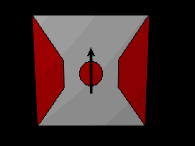
Materials Research Science and Engineering Center: Faculty Publications
Document Type
Article
Date of this Version
January 2006
Abstract
The application of nanomagnetic materials to biological systems has produced significant advances in research, diagnosis, and treatment of numerous pathologies. This chapter summarizes the major applications of magnetic materials: magnetic targeting, drug and gene delivery, magnetic separation, the use of magnetic beads in manipulating single molecules, as contrast agents in magnetic resonance imaging, and for hyperthermia. Biocompatibility requirements for magnetic materials used in these applications are reviewed.
“Nanobiomagnetism” is the intersection of nanomagnetism and medicine that focuses on biological systems and/or processes. Magnetism is an inherent facet of life, from iron in blood to the ability of magnetotactic bacteria, birds, honeybees and other creatures to navigate by the Earth’s magnetic field. Iron plays a critical part in many aspects of human neurophysiology. Naturally occurring iron in the body usually is stored within ferritin, which are 12-nm hollow spherical shells that each can hold up to 2,500 iron atoms in the form of mineralized ferrihydrite. Anomalous amounts of iron—possibly in nanoscale form—are associated with many neurodegenerative disorders such as Alzheimer’s, Parkinson’s, and Huntington’s diseases. The ability of magnets to act on objects at a distance makes them valuable medical tools. A 1624 report described the extraction of an iron splinter from an eye using a magnet. Safety pins, bullets and grenade splinters were removed using magnets. Grazing cows are fed magnets to prevent sharp metallic objects they eat from damaging the intestines. The invention of stronger, smaller permanent magnets made possible more delicate applications, such as temporarily fixing prosthesis in dentistry, guiding catheters through the body, and navigating within the brain. Nanoscale materials have a special relevance to biomedical applications due to their size compatibility with cells (10–100 μm), viruses (20–450 nm), proteins (5–50 nm) and genes (2 nm wide by 10–100 nm long). Nanoparticles are small enough to move inside the body without disrupting normal functions, and can access spaces inaccessible by other means. Cells react to the topography of their environment on size scales as small as 5 nm - up to 1000 times smaller than their own size. Changes in response to topography literally can induce growth or death. Nanostructured materials allow study of these critical processes on a single-cell level.
Notice: "The term Nanobiomagnetics ® ™ has been registered as a federal trademark by Nanobiomagnetics, Inc., of Oklahoma City, OK."


Comments
Published in Advanced Magnetic Nanostructures, edited by David J. Sellmyer and Ralph Skomski (Springer, 2006).
http://www.springer.com/east/home/generic/search/results?SGWID=5-40109-22-97856589-0
Copyright © 2006 Springer Verlag. Used by permission.